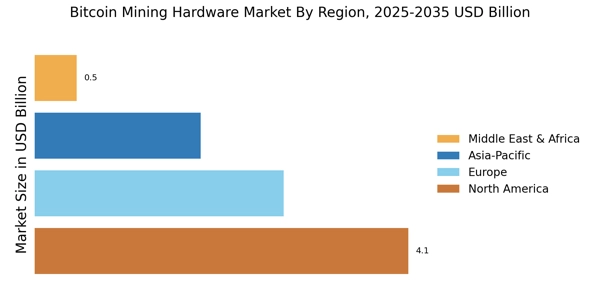Regulatory Developments
The Bitcoin Mining Hardware Market is significantly influenced by regulatory developments across various jurisdictions. Governments are increasingly establishing frameworks to govern cryptocurrency activities, which can either facilitate or hinder market growth. In 2025, several countries have implemented favorable regulations that promote mining operations, leading to a surge in hardware sales. Conversely, regions with stringent regulations may see a decline in mining activities, impacting hardware demand. Miners must navigate this complex regulatory landscape, adapting their strategies accordingly. As regulations evolve, they will play a pivotal role in shaping the future of the Bitcoin Mining Hardware Market, influencing investment decisions and operational practices.
Energy Efficiency Innovations
Energy consumption remains a critical concern within the Bitcoin Mining Hardware Market. As mining operations require substantial electricity, innovations aimed at improving energy efficiency are paramount. In 2025, the average energy consumption of mining rigs has decreased by approximately 30% due to advancements in chip technology and cooling systems. This shift not only reduces operational costs for miners but also addresses environmental concerns associated with high energy usage. Companies that prioritize energy-efficient solutions are likely to gain a competitive edge, as sustainability becomes a key factor in consumer decision-making. Thus, the focus on energy efficiency is expected to drive growth in the Bitcoin Mining Hardware Market.
Growing Institutional Investment
Institutional investment in cryptocurrencies is reshaping the Bitcoin Mining Hardware Market. In 2025, major financial institutions and hedge funds are increasingly allocating capital to Bitcoin mining operations, recognizing the potential for substantial returns. This influx of institutional capital is driving demand for high-performance mining hardware, as these entities seek to optimize their operations. The presence of institutional players not only legitimizes the market but also encourages further investment and innovation. As institutional interest continues to grow, the Bitcoin Mining Hardware Market is likely to witness increased competition and advancements in mining technology, ultimately benefiting all stakeholders involved.
Increased Demand for Cryptocurrency
The Bitcoin Mining Hardware Market experiences heightened demand as more individuals and institutions invest in cryptocurrencies. This surge in interest is driven by the increasing acceptance of Bitcoin as a legitimate asset class. In 2025, the number of Bitcoin wallets has surpassed 100 million, indicating a growing user base. As more participants enter the market, the need for efficient and powerful mining hardware intensifies. Miners seek advanced equipment to maximize their returns, leading to a competitive landscape where innovation is crucial. Consequently, manufacturers are compelled to enhance their offerings, resulting in a dynamic market environment. This trend suggests that the Bitcoin Mining Hardware Market will continue to expand as cryptocurrency adoption becomes more mainstream.
Technological Advancements in Mining Equipment
Technological advancements are a driving force in the Bitcoin Mining Hardware Market. The introduction of more powerful and efficient mining equipment has transformed the landscape, enabling miners to achieve higher hash rates and improved performance. In 2025, the latest ASIC miners are capable of delivering hash rates exceeding 100 TH/s, significantly enhancing mining efficiency. This technological evolution not only boosts profitability for miners but also attracts new entrants to the market. As competition intensifies, manufacturers are compelled to innovate continuously, leading to a cycle of rapid advancements. Consequently, the relentless pursuit of technological superiority is expected to propel the Bitcoin Mining Hardware Market forward.


















Leave a Comment